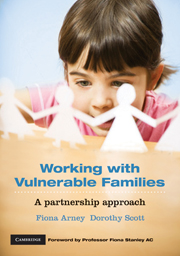Book contents
- Frontmatter
- Foreword
- Contents
- List of figures, tables and boxes
- Contributors
- Acknowledgements
- Introduction
- Chapter 1 Think child, think family, think community
- Chapter 2 Family strengths: an international perspective
- Chapter 3 Harnessing ‘resilience’ when working with children and families
- Chapter 4 Working within and between organisations
- Chapter 5 Family-centred practice in early childhood settings
- Chapter 6 Sustained nurse home visiting with families of Aboriginal children
- Chapter 7 Including fathers in work with vulnerable families
- Chapter 8 Parenting in a new culture: working with refugee families
- Chapter 9 Responding to parents with complex needs who are involved with statutory child protection services
- Chapter 10 Engaging family members in decision making in child welfare contexts
- Chapter 11 Supporting parents whose children are in out-of-home care
- Chapter 12 Using evidence-informed practice to support vulnerable families
- Chapter 13 Spreading promising ideas and innovations in child and family services
- Index
Chapter 8 - Parenting in a new culture: working with refugee families
- Frontmatter
- Foreword
- Contents
- List of figures, tables and boxes
- Contributors
- Acknowledgements
- Introduction
- Chapter 1 Think child, think family, think community
- Chapter 2 Family strengths: an international perspective
- Chapter 3 Harnessing ‘resilience’ when working with children and families
- Chapter 4 Working within and between organisations
- Chapter 5 Family-centred practice in early childhood settings
- Chapter 6 Sustained nurse home visiting with families of Aboriginal children
- Chapter 7 Including fathers in work with vulnerable families
- Chapter 8 Parenting in a new culture: working with refugee families
- Chapter 9 Responding to parents with complex needs who are involved with statutory child protection services
- Chapter 10 Engaging family members in decision making in child welfare contexts
- Chapter 11 Supporting parents whose children are in out-of-home care
- Chapter 12 Using evidence-informed practice to support vulnerable families
- Chapter 13 Spreading promising ideas and innovations in child and family services
- Index
Summary
Learning goals
This chapter will enable you to:
Understand the experiences of refugee and newly arrived migrants
Reflect on the personal and professional challenges that may be faced when responding to the needs of refugee and newly arrived migrants
Develop an understanding of the cultural and parenting differences that may contribute to parents and families from refugee backgrounds being involved with the child protection system
Recognise the potential of practitioners to engage parents from refugee backgrounds in ways that will enhance their ability to parent in Australia
Learn about an innovative exemplar of working with refugee families
Think about how different professions and services can work together for and with refugee families.
Introduction
The house was full of women and children and since we were one of the last ones in, we had to sleep under the roof. It was very unsafe where we tried to fall asleep. We lay next to an open area, which looked down on to the first floor. Since the house wasn't finished it didn't have a fence on the stairs or that area where we slept. The noise of grenades and guns made it impossible for us to fall asleep because they were basically falling somewhere near us. You could feel them and sometimes it felt that bullets were knocking on the roof, which was right above our heads. […]
- Type
- Chapter
- Information
- Working with Vulnerable FamiliesA Partnership Approach, pp. 157 - 186Publisher: Cambridge University PressPrint publication year: 2010
- 3
- Cited by



